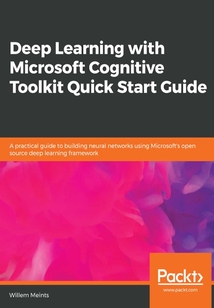舉報 

會員
Deep Learning with Microsoft Cognitive Toolkit Quick Start Guide
CognitiveToolkitisaverypopularandrecentlyopensourceddeeplearningtoolkitbyMicrosoft.CognitiveToolkitisusedtotrainfastandeffectivedeeplearningmodels.ThisbookwillbeaquickintroductiontousingCognitiveToolkitandwillteachyouhowtotrainandvalidatedifferenttypesofneuralnetworks,suchasconvolutionalandrecurrentneuralnetworks.Thisbookwillhelpyouunderstandthebasicsofdeeplearning.YouwilllearnhowtouseMicrosoftCognitiveToolkittobuilddeeplearningmodelsanddiscoverwhatmakesthisframeworkuniquesothatyouknowwhentouseit.Thisbookwillbeaquick,no-nonsenseintroductiontothelibraryandwillteachyouhowtotraindifferenttypesofneuralnetworks,suchasconvolutionalneuralnetworks,recurrentneuralnetworks,autoencoders,andmore,usingCognitiveToolkit.Thenwewilllookattwoscenariosinwhichdeeplearningcanbeusedtoenhancehumancapabilities.Thebookwillalsodemonstratehowtoevaluateyourmodels'performancetoensureittrainsandrunssmoothlyandgivesyouthemostaccurateresults.Finally,youwillgetashortoverviewofhowCognitiveToolkitfitsintoaDevOpsenvironment.
目錄(158章)
倒序
- coverpage
- Title Page
- Copyright and Credits
- Deep Learning with Microsoft Cognitive Toolkit Quick Start Guide
- Dedication
- About Packt
- Why subscribe?
- Packt.com
- Contributors
- About the author
- About the reviewer
- Packt is searching for authors like you
- Preface
- Who this book is for
- What this book covers
- To get the most out of this book
- Download the example code files
- Code in Action
- Conventions used
- Get in touch
- Reviews
- Getting Started with CNTK
- The relationship between AI machine learning and deep learning
- Limitations of machine learning
- How does deep learning work?
- The neural network architecture
- Artificial neurons
- Predicting output with a neural network
- Optimizing a neural network
- What is CNTK?
- Features of CNTK
- A high-speed low-level API
- Basic building blocks for quickly creating neural networks
- Measuring model performance
- Loading and processing large datasets
- Using models from C# and Java
- Installing CNTK
- Installing on Windows
- Installing Anaconda
- Upgrading pip
- Installing CNTK
- Installing on Linux
- Installing Anaconda
- Upgrading pip to the latest version
- Installing the CNTK package
- Using your GPU with CNTK
- Enabling GPU usage on Windows
- Enabling GPU usage on Linux
- Summary
- Building Neural Networks with CNTK
- Technical requirements
- Basic neural network concepts in CNTK
- Building neural networks using layer functions
- Customizing layer settings
- Using learners and trainers to optimize the parameters in a neural network
- Loss functions
- Model metrics
- Building your first neural network
- Building the network structure
- Choosing an activation function
- Choosing an activation function for the output layer
- Choosing an activation function for the hidden layers
- Picking a loss function
- Recording metrics
- Training the neural network
- Choosing a learner and setting up training
- Feeding data into the trainer to optimize the neural network
- Checking the performance of the neural network
- Making predictions with a neural network
- Improving the model
- Summary
- Getting Data into Your Neural Network
- Technical requirements
- Training a neural network efficiently with minibatches
- Working with small in-memory datasets
- Working with numpy arrays
- Working with pandas DataFrames
- Working with large datasets
- Creating a MinibatchSource instance
- Creating CTF files
- Feeding data into a training session
- Taking control over the minibatch loop
- Summary
- Validating Model Performance
- Technical requirements
- Choosing a good strategy to validate model performance
- Using a hold-out dataset for validation
- Using k-fold cross-validation
- What about underfitting and overfitting?
- Validating performance of a classification model
- Using a confusion matrix to validate your classification model
- Using the F-measure as an alternative to the confusion matrix
- Measuring classification performance in CNTK
- Validating performance of a regression model
- Measuring the accuracy of your predictions
- Measuring regression model performance in CNTK
- Measuring performance for out-of-memory datasets
- Measuring performance when working with minibatch sources
- Measuring performance when working with a manual minibatch loop
- Monitoring your model
- Using callbacks during training and validation
- Using ProgressPrinter
- Using TensorBoard
- Summary
- Working with Images
- Technical requirements
- Convolutional neural network architecture
- Network architecture used for image classification
- Working with convolution layers
- Working with pooling layers
- Other uses for convolutional networks
- Building convolutional networks
- Building the network structure
- Training the network with images
- Picking the right combination of layers
- Improving model performance with data augmentation
- Summary
- Working with Time Series Data
- Technical requirements
- What are recurrent neural networks?
- Recurrent neural networks variations
- Predicting a single output based on a sequence
- Predicting a sequence based on a single sample
- Predicting sequences based on sequences
- Stacking multiple recurrent layers
- How do recurrent neural networks work?
- Making predictions with a recurrent neural network
- Training a recurrent neural network
- Using other recurrent layer types
- Working with gated recurrent units
- Working with long short-term memory units
- When to use other recurrent layer types
- Building recurrent neural networks with CNTK
- Building the neural network structure
- Stacking multiple recurrent layers
- Training the neural network with time series data
- Predicting output
- Summary
- Deploying Models to Production
- Technical requirements
- Using machine learning in a DevOps environment
- Keeping track of your data
- Training models in a continuous integration pipeline
- Deploying models to production
- Gathering feedback on your models
- Storing your models
- Storing model checkpoints to continue training at a later point
- Storing portable models for use in other applications
- Storing a model in ONNX format
- Using ONNX models in C#
- Using Azure Machine Learning service to manage models
- Deploying Azure Machine Learning service
- Exploring the machine learning workspace
- Running your first experiment
- Deploying your model to production
- Summary
- Other Books You May Enjoy
- Leave a review - let other readers know what you think 更新時間:2021-07-02 12:08:59
推薦閱讀
- 數據庫基礎教程(SQL Server平臺)
- MySQL數據庫進階實戰
- LibGDX Game Development Essentials
- Hands-On Data Structures and Algorithms with Rust
- 有趣的二進制:軟件安全與逆向分析
- Microsoft SQL Server企業級平臺管理實踐
- Unity 5.x Game AI Programming Cookbook
- SQL Server 2008數據庫應用技術(第二版)
- 大數據可視化
- 業務數據分析:五招破解業務難題
- 數據庫應用基礎教程(Visual FoxPro 9.0)
- WS-BPEL 2.0 Beginner's Guide
- 智能數據時代:企業大數據戰略與實戰
- Oracle 12c云數據庫備份與恢復技術
- 達夢數據庫運維實戰
- 新手學會計(2013-2014實戰升級版)
- Access數據庫開發從入門到精通
- 云計算寶典:技術與實踐
- openGauss數據庫核心技術
- 中國云存儲發展報告
- 大數據分析:R基礎及應用
- Microsoft Dynamics NAV 2015 Professional Reporting
- Hadoop與大數據挖掘
- SQL面試寶典:圖解數據庫求職題
- 數據質量實踐手冊:4步構建高質量數據體系
- Access 2010數據庫程序設計
- Spark 3.0大數據分析與挖掘:基于機器學習
- 收獲,不止Oracle(第2版)
- 數據庫原理及MySQL應用教程
- Hadoop HDFS深度剖析與實踐

